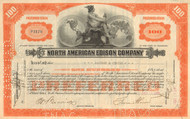Categories
Categories
- Home
- Aviation
- Aircraft, parts, services
- North American Aviation Inc 1967 (merged with Rockwell then Boeing)
North American Aviation Inc 1967 (merged with Rockwell then Boeing)
Product Description
North American Aviation Inc stock certificate 1967
Uncommon aviation piece. Nice vignette of two classical female figures flanking the company logo. Issued and cancelled. Dated 1967.
North American Aviation (NAA) was a major American aerospace manufacturer, responsible for a number of historic aircraft, including the T-6 Texan trainer, the P-51 Mustang fighter, the B-25 Mitchell bomber, the F-86 Sabre jet fighter, the X-15 rocket plane, and the XB-70, as well as Apollo Command and Service Module, the second stage of the Saturn V rocket, the Space Shuttle orbiter and the B-1 Lancer. Through a series of mergers and sales, North American Aviation became part of Rockwell International and is now part of Boeing.
Clement Melville Keys founded North American on December 6, 1928, as a holding company that bought and sold interests in various airlines and aviation-related companies. However, the Air Mail Act of 1934 forced the breakup of such holding companies. North American became a manufacturing company, run by James H. "Dutch" Kindelberger, who had been recruited from Douglas Aircraft Company. NAA did retain ownership of Eastern Air Lines until 1938.
General Motors Corporation took a controlling interest in NAA and merged it with its General Aviation division in 1933, but retained the name North American Aviation. Kindelberger moved the company's operations from Dundalk, Maryland to Los Angeles, California, which allowed flying year-round, and decided to focus on training aircraft, on the theory that it would be easier than trying to compete with established companies on larger projects.
The twin-engine B-25 Mitchell bomber achieved fame in the Doolittle Raid and was used in all combat theaters of operation. The P-51 Mustang was initially produced for Britain as an alternative to the Curtiss P-40 Warhawk, which North American had declined to produce under license. The derivative A-36 Apache was developed as a ground attack aircraft and dive bomber. A suggestion by the RAF that North American switch the P-51's powerplant from its original Allison engine to the Rolls-Royce Merlin engine may have been one of the most significant events in WWII aviation, as it transformed the P-51 into what many consider to be the best American fighter of the war.
The North American F-86 Sabre started out as a redesigned Fury and achieved fame shooting down MiGs in the Korean War. Over 9,000 F-86s were produced. Its successor, the North American F-100 Super Sabre, was also popular. Some 6,656 F-86s were produced in the United States, the most postwar military aircraft in the West, as well as another 2,500 elsewhere. To accommodate its Sabre production, North American opened facilities in a former Curtiss-Wright plant in Columbus, Ohio. It also moved into a former Consolidated-Vultee Aircraft plant at Downey, California, and in 1948, built a new plant at Downey.
In 1955, the rocket engine operations were spun off into a separate division as Rocketdyne. This division furnished engines for the Redstone, Jupiter, Thor, Delta, and Atlas missiles, and for NASA's Saturn family of launch vehicles.
In March 1967, it merged with Rockwell-Standard, and the merged company became known as North American Rockwell. Within two years the new company was studying concepts for the Space Shuttle, and won the orbiter contract in 1972. The company changed its name again to Rockwell International and named its aircraft division North American Aircraft Operations in 1973.
Rockwell International's defense and space divisions (including the North American Aviation divisions Autonetics and Rocketdyne) were sold to Boeing in December 1996. Initially called Boeing North American, these groups were integrated with Boeing's Defense division. Rocketdyne was eventually sold by Boeing to UTC Pratt & Whitney in 2005. UTC later sold Rocketdyne to Aerojet (GenCorp) in 2013.
 Loading... Please wait...
Loading... Please wait... 








